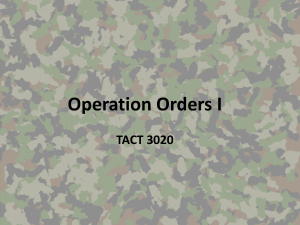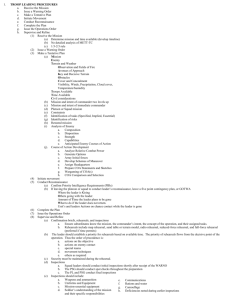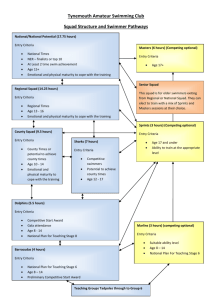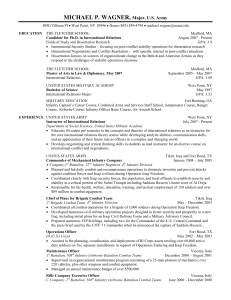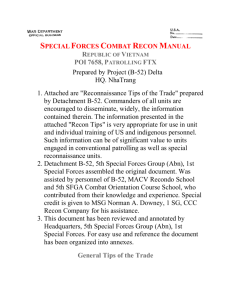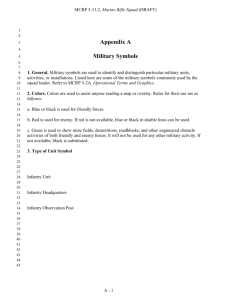116 Ground Combat Element
advertisement
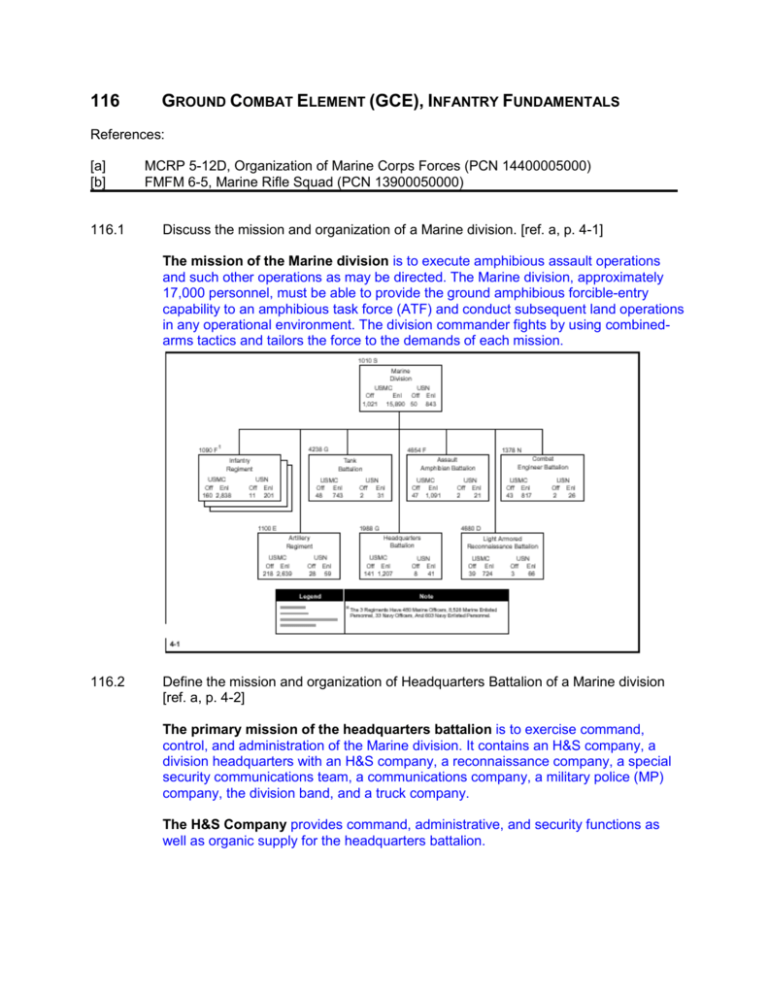
116 GROUND COMBAT ELEMENT (GCE), INFANTRY FUNDAMENTALS References: [a] [b] 116.1 MCRP 5-12D, Organization of Marine Corps Forces (PCN 14400005000) FMFM 6-5, Marine Rifle Squad (PCN 13900050000) Discuss the mission and organization of a Marine division. [ref. a, p. 4-1] The mission of the Marine division is to execute amphibious assault operations and such other operations as may be directed. The Marine division, approximately 17,000 personnel, must be able to provide the ground amphibious forcible-entry capability to an amphibious task force (ATF) and conduct subsequent land operations in any operational environment. The division commander fights by using combinedarms tactics and tailors the force to the demands of each mission. 116.2 Define the mission and organization of Headquarters Battalion of a Marine division [ref. a, p. 4-2] The primary mission of the headquarters battalion is to exercise command, control, and administration of the Marine division. It contains an H&S company, a division headquarters with an H&S company, a reconnaissance company, a special security communications team, a communications company, a military police (MP) company, the division band, and a truck company. The H&S Company provides command, administrative, and security functions as well as organic supply for the headquarters battalion. The Reconnaissance Company provides ground reconnaissance and surveillance in support of the division or its subordinate elements. The company consists of a company headquarters section and six reconnaissance platoons. Employment of the company emphasizes directed reconnaissance rather than passive surveillance. The MP Company provides route reconnaissance, evacuation and control of enemy prisoners of war (EPW), beach and perimeter defense, area security, crowd control, and investigative services. The Communications Company installs, operates, and maintains communications facilities for the division headquarters, including multichannel radio, wire, and communications center facilities The Truck Company provides general support motor transport to the Marine division. 116.3 Discuss the mission and organization of the Marine Corps Regiment. [ref. a, pp. 4-3, 4-4] The primary mission of the infantry regiment is to locate, close with, and destroy the enemy by fire and maneuver or to repel his assault by fire and close combat. The infantry regiment consists of a headquarters company and two or more infantry battalions (normally three infantry battalions, approximately 3,400 personnel in a regiment). The infantry battalions are the basic tactical units with which the regiment accomplishes its mission. The headquarters company of the infantry regiment contains a regimental headquarters and a reconnaissance platoon. When combined with other combat support and CSS units, it will form a regimental landing team. Command and staff functions for the regiment are exercised through a compact operational command group that consists of the commander and an executive staff. The staff is capable of integrating the efforts of attached units with those of supporting units. The staff can support a tactical, main, and rear command echelon during displacement. The basic means of ground mobility of the regiment is by foot, supplemented by small, lightweight vehicles for transportation of electronic equipment, weapons, and limited amounts of ammunition and supplies. All elements are helicopter transportable and compatible with other means of transportation (e.g., assault amphibious vehicles (AAVs), motor transport, fixed-wing aircraft, and ships). 116.4 Discuss the organization of the Headquarters Company, Infantry Regiment. [ref. a, p. 4-4] 116.5 Discuss the mission and organization of the Marine Corps Infantry Battalion, Infantry Regiment. [ref. a, pp. 4-5 thru 4-8] The primary mission of the infantry battalion is to locate, close with, and destroy the enemy by fire and maneuver or to repel his assault by fire and close combat. The infantry battalion consists of an H&S company, a weapons company, and three rifle companies. The rifle companies are the basic tactical units with which the battalion accomplishes its mission. When the battalion is combined with combat support and CSS units, it forms a battalion landing team (BLT). 116.6 Discuss the organization of the H & S Company, Infantry Battalion. [ref. a, p. 4-6] 116.7 Discuss the organization of the Weapons Company, Infantry Battalion. [ref. a, p. 4-7] 116.8 Discuss the organization of the Rifle Company, Infantry Battalion. [ref. a, p. 4-7] 116.9 Discuss the weapons distribution within a rifle company. [ref. a, pp. 4-8, 4-9] Within the rifle company, the fire team leader carries an M16A2 rifle and an M203 grenade launcher. The squad automatic rifleman carries the M249 squad automatic weapon (SAW); all other riflemen, including the assistant automatic rifleman, carry an M16A2. Squad leaders and the officers and enlisted personnel of the platoon headquarters carry M16A2 rifles. The weapons platoon machine gun section has six M240G machine guns, the mortar section has three M224 60-mm mortars, and the assault section has six MK153 83-mm shoulder-launched multipurpose assault weapons (SMAWs). The weapons company mortar platoon has 8 M252 81-mm mortars, the antiarmor platoon has 12 M47 Dragons, and its tube-launched, optically tracked, wire command link guided missile (TOW) section has 8 TOWs. The heavy machine gun platoon has six each of M2 .50-cal machine guns and MK19 40-mm grenade machine guns. 116.10 Discuss the mission of a rifle squad. [ref. b, p. 1-1] The mission of the rifle squad is to locate, close with, and destroy the enemy by fore and maneuver, or repel the enemy’s assault by fire and close combat. 116.11 Discuss the organization of a rifle squad. [ref. b, p. 1-1] The rifle squad consists of three fire teams, each of which is built around an automatic weapon and controlled by a fire team leader 116.12 Discuss the duties and responsibilities of the following: [ref. b, p. 1-5] Squad leader carries out the orders issued to him by the platoon commander. He is responsible for the discipline, appearance, training, control, conduct, and welfare of his squad at all times, as well as the condition, care, and economical use of its weapons and equipment. In combat, he is also responsible for the tactical employment, fore discipline, fire control, and maneuver of his squad. He takes position where he can best carry out his orders of the platoon commander and observe and control the squad. Fire team leader/grenadier carries out the orders of the squad leader. He is responsible for the fire discipline and control of his fire team and economical use of its weapons and equipment. In carrying out the orders of the squad leader, he takes a position to best observe and control the fire team. Normally, he is close enough to the automatic rifleman to exercise effective control of his fires. In addition to his primary duties as a leader, but not to the detriment of them, he serves as a grenadier and is responsible for the effective employment of the grenade launcher, his rifle, and for the condition and care of his weapon and equipment. The senior fire team leader in the squad serves as assistant squad leader Automatic rifleman carries out the orders of the fire team leader. He is responsible for the effective employment of the automatic rifle and for the condition and care of his weapon and equipment Assistant automatic rifleman assists in the employment of the automatic rifle. He carries additional magazines and/or ammunition boxes for his automatic rifle and is prepared to assume the duties of the automatic rifleman. He is responsible for the effective employment of the automatic rifle and for the condition and care of his weapon and equipment Rifleman in the fire team carries out the orders of the fire team leader. He is responsible for the effective employment of his rifle and for the condition and care of his weapon and equipment. The rifleman is trained as a scout 116.13 State the three fighting positions. [ref. b, pp. 5-3, 5-4] A fighting position is a location on the ground from which fire is delivered by an individual, a fire unit (squad or fire team), or a crew-served weapon. Before selecting a firing position, the assigned sector of fire must be carefully examined from various locations using the prone position to ensure effective coverage of the sector of fire. The exact fighting position is then designated on the ground prior to digging in. The position must allow for good fields of fire, make maximum use of available cover and concealment, and facilitate exercise of fire control by the unit leader. Primary Fighting Position – is the best available position from which the assigned sector of fire can be covered. Individuals, fire teams, squads, and crew-served weapons are assigned primary fighting positions. Alternate Fighting Positions – are not normally assigned to individuals or units within the platoon. They are used primarily by crew-served weapons. An alternate fighting position is located so that a crew-served weapon can continue to accomplish its origninal mission when the primary position becomes untenable or unsuited for carrying out that mission. Supplementary Fighting Position – One of the greatest threats to either the attacker or the defender lies in being surprised. The attacker seeks to surprise the defender by concealing his movements until the moment of the assault. The defender seeks to surprise the attacker by concealing the exact location and the extent of his dispositions, thus leading his opponent into a false estimate of the situation and consequently, a faulty decision. Supplementary positions are prepared to guard against attack from directions other than those from which the main attack is expected. A supplementary position is a secondary position and does not cover the same sector of fire as the primary position. In some situations, the most likely avenue of approach may vary between daylight and darkness of other periods of low visibility. Thus, the requirement to shift positions becomes an absolute necessity. This situation is more the rule rather than the exception. Supplementary positions actually provide security. When occupied, they insure protection against attack from directions other than those covered by primary positions. Movement to supplementary position should be made by covered and concealed routes when available 116.14 State the eight guidelines that should be observed when clearing the fields of fire. [ref. b, pp. 5-21 thru 5-23] In clearing fields of fire forward of each fighting position, the following guidelines should be observed: - Do not disclose the squad’s fighting position by excessive or careless clearing. - Start clearing near the fighting position and work forward to the limits of effective small arms fire. - In all cases, leave a thin natural screen of foliage to hide fighting positions. - In sparsely wooded areas, remove the lower branches of scattered large trees. It may be desirable to remove entire trees which might be used as reference points for enemy fire. -In heavy woods, complete clearing of the field of fire is neither possible or desirable. Restrict work to thinning undergrowth and removing lower branches of large trees. In addition, clear narrow lane of fire for automatic weapons. -If practical, demolish buildings and walls forward of the fighting position which may obstruct fields of fire or provide cover and concealment to the enemy. - Move cut brush to locations where it will not furnish concealment to the enemy or disclose the squad’s fighting position. - Extreme care must be taken by the fire team leader to insure that fields of fire are cleared of obstructions which might cause premature detonation of M203 projectiles 116.15 Define the acronym FPF. [ref. b, p. 5-31] Final Protective Fires - If the enemy’s attack is not broken and he begins his assault, final protective fires are called. Final Protective Fires are the final attempt to stop the enemy attack before he reaches the platoon’s battle position. When final protective fires are called for, all squad members fire in their assigned sectors (normally the fire team’s sector of fire). Rifles and M203’s continue to fire at an average rate; the automatic rifleman will increase their volume of fire to the rapid rate, if they have not yet reached this rate prior to the calling for final protective fires. Riflemen engage enemy personnel within the fire team sector; fire team leaders fire the M-203 at the largest concentration of enemy personnel within the fire team sector. Normally the largest concentrations will be along the PDF’s of the automatic rifles if the PDF’s were properly positioned. 116.16 Define the term checkpoint. [ref. b, p. 8-23] A checkpoint is a predetermined point on the ground used as a means of controlling movement. During his map study or physical reconnaissance, the patrol leader decides the number and locations of checkpoints plotted along the patrol route. These are coordinated with his parent unit before the patrol leaves. Checkpoints are assigned numbers, not in sequential order. Normally, the patrol leader will call upon reaching checkpoints so that the parent unit will be able to follow the progress of the patrol toward the objective and on its return to friendly lines/area 116.17 Define the term rally point. [ref. b, p. 8-23] A rally point is an easily identifiable point on the ground, designated by the patrol leader, where the patrol can reassemble/reorganize if it becomes dispersed. It should provide cover and concealment and be defensible for a short time. All rally points are considered tentative until they are reached, found to be suitable, and designated by the patrol leader. He ensures that all patrol members are notified when rally point is so designated, either by arm-and-signal or by passing the word orally. He also points out identifying features, which mark the limits of the rally point 116 .18 Define the following types of rally points: [ref. b, pp. 8-23, 8-24] Initial - This is a point within the friendly area where the patrol can reassemble if it becomes dispersed before departing the friendly area of before reaching the first rally point designated en route. It may be the patrol assembly area. The initial rally point location must be coordinated with the commander in whose area it lies. En route - These are points selected along the patrol’s route to the objective and from the objective back to friendly lines/area. The patrol leader selects them as the patrol passes through likely areas for which rally points are needed. Objective - This is the rally point nearest the objective at which the patrol reassembles after the mission is accomplished. It may be located short of, to a flank, or beyond the objective. This may also be used as the final preparation point. 116.19 Discuss and explain the tactics used to react to an ambush. [ref. b, pp. 8-28, 8-29] COUNTERAMBUSH DRILLS - When a patrol is ambushed, the IA drill used is determined by whether the ambush is near (enemy within fifty meters of the patrol) or far (enemy beyond fifty meters of patrol). Fifty meters is considered the limit from which the ambush can launch an assault against the enemy. In a NEAR ambush, the killing zone is under very heavy, highly concentrated, close range fires. There is little time or space for men to maneuver or seek cover. The longer they remain in the killing zone, the more certain of their deaths. If attacked from a near ambush: - Men in the killing zone immediately assault the enemy’s position without waiting for any order or signal. The assault should be swift, violent and destructive. The men fire their weapons at the maximum rate, throw hand grenades, and yell as loudly as possible - anything to kill as many enemy as they can, and confuse the enemy survivors. Once they reach the ambush position, they continue with their assault, or break contact, as directed. - Men not in the killing zone maneuver against the ambush force, firing in support of those assaulting. - If the ambush force is small enough to be routed or destroyed, the patrol members should continue with their assault and supporting fire. If the force is well-disciplined and holds its ground, then the patrol members should make every effort to break contact as quickly as possible, and move to the last en route rally point to reorganize. In a FAR ambush, the killing zone is also under very heavy, highly concentrated fires, but from greater range. The greater range precludes those caught in the killing zone from conducting an assault. The greater range does, however, permit some opportunity for the men to maneuver and seek cover. If attacked from a FAR ambush: - Men in the killing zone immediately return fire, take the best available cover, and continue firing until directed otherwise. - Men not in the killing zone maneuver against the ambush force, as directed. - The patrol leader either directs his unit and team leaders to fire and maneuver against the ambush force, or to break contact, depending on his rapid assessment of the situation. In each situation, the success of the counterambush drill employed is dependent on the men being well-trained in recognizing the nature of an ambush and well-rehearsed in the proper actions to take. Each man has to be confident in himself, his abilities, and those of his fellow Marines. He can’t wait for someone to tell him what to do, as his leaders may become casualties. Training gives the Marine the confidence and ability to do whatever it takes to accomplish the mission. 116.20 Identify the five types of patrols used by the Marine Corps rifle squad. [ref. b, p. 8-34] Combat patrols are assigned missions which usually require them to actively engage the enemy. As a secondary mission, they collect and report information about the enemy and terrain. Combat patrols are employed in both offensive and defensive operations. Combat patrols can inflict damage on the enemy, establish or maintain contact with friendly or enemy forces, deny the enemy access to key terrain, probe the enemy positions, and protect against surprise and ambush. Raid patrols – destroy or capture enemy personnel or equipment, destroy installations, or free friendly personnel who have been captured by the emeny. Contact Patrols – establish and/or maintain contact with friendly or enemy forces. Economy of Force Patrols – perform limited objective missions such as seizing and holding key terrain to allow maximum forces to be used elsewhere. Ambush patrols – conduct ambushes of enemy patrols, carrying parties, foot columns, and convoys. Security patrols – detect infiltration by the enemy, kill or capture infiltrators, and protect against surprise or ambush

